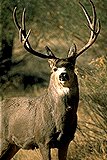
Deer antlers are a valuable appendage according to one
wildlife biologist. They may look like excess baggage, but nature
has adorned most male deer with antlers for some very good
reasons. They're handy as weapons in the mating season, serve as
"air conditioners" in hot weather and provide
nourishment for other animals after they're shed.
Antlers begin to grow in early spring, starting as soft, swollen pads on the skill and lengthening into club-like structures. While growing, antlers are covered with a soft brown-haired skin called "velvet." Right under this skin are many tiny blood vessels that carry food and minerals to the growing antlers. While the antlers are in velvet, they can be hurt very easily. A male deer in velvet is careful to jump out of the way of low hanging branches. If an antler is knocked against a tree during the velvet stage, it will bleed.
Within four to five months, the antlers are full-sized. On the moose, full-sized can mean more than seven feet wide from tip to tip and weigh more than 45 pounds. They attain these impressive proportions in just three or four months, making them the fastest growing tissue known.
During mating or rutting season, a buck uses his antlers to fight other males. With a quick lunge one male will attack a rival head on and lock antlers. After a few minutes of shoving and pushing, during which pieces of antler may be broken, the weaker male will usually retreat, leaving the victor with the female deer in the territory.
During the summer when a buck's antlers are growing, they act as an air conditioner to help get rid of extra body heat. At full size, antlers harden beneath their velvet and the blood supply stops. The dead and dry velvet peels off in strips, aided by the bucks' vigorous rubbing against trees and bushes.
Most bucks shed their antlers in January and February. The antler is easily separated from the skill bone, looking like a leaf attached to a twig. It separates level and smooth with no jagged edges. Around the break there may be a little blood, but the main exposed wound is where the cells between the antler material and skill weakened, letting the heavy antler fall. If the burr at the base of the antler remains, the antler is broken, not shed.
This cycle is the same will all of the more than 50 kinds of deer in the world except the Himalayan musk deer, which have long curved teeth to protect them, and the Chinese water deer, which have long, sharp tusks. The female caribou and reindeer are the only female deer to grow antlers.
Shed antlers no longer serve the deer, but they are a welcome sight to other forest dwellers. Because they are made of calcium, salt, and other minerals important in the diet, many animals such as mice, chipmunks, squirrels, and porcupines gnaw away at them.